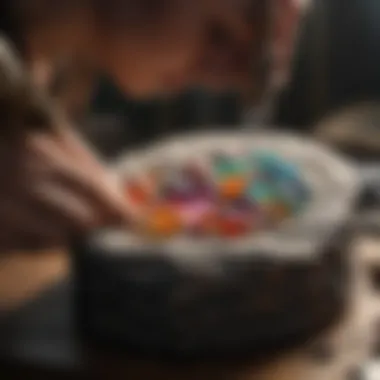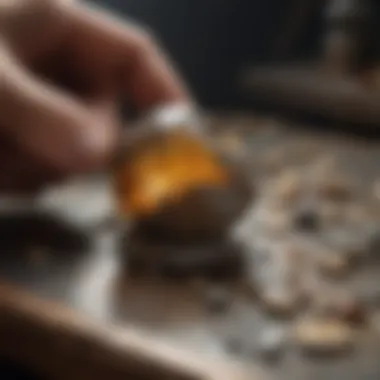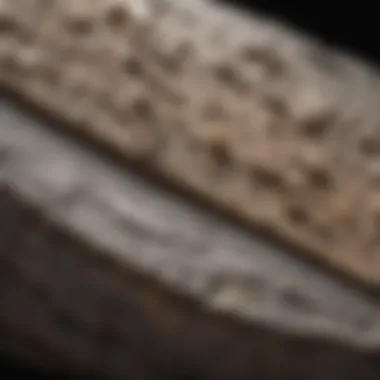Unveiling the Best Polishing Tools for Dremel: Expert Guide for Rock and Fossil Enthusiasts


Rock and Fossil Identification
In the realm of rock and fossil identification, it is imperative to grasp the diverse types of rocks and fossils that one may encounter. From sedimentary rocks like limestone to metamorphic ones such as marble, each harbors distinct characteristics waiting to be explored. Fossils, ranging from petrified wood to ancient marine creatures trapped in stone, offer a glimpse into our planet's captivating history. To hone one's identification skills, utilizing tools like magnifying glasses, scratch tests, and UV lights becomes essential for dissecting the minute details that distinguish one specimen from another.
Collecting Tips and Techniques
Embarking on a fossil and rock collection journey requires adept knowledge of best practices and techniques. Selecting prime collecting sites involves meticulous research into geological maps and local regulations to ensure a fruitful exploration. Once on-site, employing tools like rock hammers, chisels, and brushes with gentle yet precise movements aids in safely extracting specimens without causing damage. Strategies for categorizing and labeling finds streamline the collection process, enhancing organization and documentation for future reference and study.
Preservation and Display
The art of preserving rocks and fossils involves employing techniques that maintain the integrity and longevity of specimens. Proper storage methods such as acid-free boxes, silica gel packets, and temperature-controlled environments shield delicate finds from deterioration. Creative display ideas, ranging from custom-made shelving to illuminated cases, allow enthusiasts to showcase their curated collection while safeguarding its beauty for generations to come.
Geological Insights
Delving into geological insights unveils the fascinating world of rock formations and processes that have sculpted our planet over millennia. Unraveling the historical significance of rocks and fossils sheds light on past ecosystems, climate shifts, and evolutionary milestones. Studying notable discoveries in the field, like the Burgess Shale fossils or the Chicxulub crater, provides valuable glimpses into Earth's intricate tapestry, inviting collectors to partake in a rich tapestry of scientific discovery and exploration.
Introduction to Polishing Tools for Dremel
In the realm of rock and fossil collecting, the utilization of polishing tools for Dremel holds significant importance. These tools serve as the gateway to enhancing the aesthetic appeal and preserving the integrity of geological specimens. Aiming to elevate the beauty and quality of collected rocks and fossils, mastering the art of polishing with Dremel tools becomes imperative.
Understanding the Importance of Polishing
Enhancing Aesthetics
When it comes to rock and fossil collections, enhancing aesthetics through polishing plays a pivotal role. The process of polishing not only enhances the visual allure of specimens but also brings out intricate details and colors embedded within the rocks and fossils. By smoothing out rough surfaces and unveiling hidden beauty, enhancing aesthetics through polishing adds a new dimension to the collectibles, making them more visually captivating and appealing to collectors.
Preserving Specimen Integrity
Preserving the integrity of specimens is another critical aspect of polishing with Dremel tools. By carefully refining the surfaces without compromising the natural form of the rocks or fossils, polishing aids in maintaining the original characteristics and features of the specimens. This preservation ensures that the geological elements remain authentic and untouched, adding value to the collection and preserving the historical significance of each piece.
Overview of Dremel Polishing Tools
Polishing Bits


One of the key components of Dremel's polishing tools is the variety of polishing bits available. These bits come in different shapes and sizes, each designed for specific purposes such as grinding, smoothing, or buffing. The versatility of polishing bits allows collectors to cater to different needs based on the type of rock or fossil being polished. With high-quality materials and precise craftsmanship, polishing bits provide efficiency and precision in the polishing process.
Polishing Pads
Complementing the polishing bits, Dremel offers a range of polishing pads that further enhance the polishing experience. These pads, made from specialized materials, help in achieving desired finishes and textures on geological specimens. Whether it's a glossy finish or a matte texture, polishing pads play a crucial role in the final polishing stages. Their flexibility and durability make them indispensable tools for rock and fossil collectors seeking professional-level results in their polishing endeavors.
Types of Polishing Tools for Dremel
In the realm of rock and fossil collection, the significance of different types of polishing tools for Dremel cannot be overstated. These tools play a crucial role in enhancing the appearance and quality of geological specimens, making them more visually appealing and preserving their integrity. Whether it's bringing out the natural beauty of a rock or highlighting intricate fossil details, the right polishing tools can truly elevate a collector's entire collection.
Diamond Coated Bits
Benefits of Diamond Coating
Delving into the realm of diamond-coated bits unveils a realm of advantages that make them a popular choice for polishing enthusiasts. The key characteristic of diamond coating lies in its exceptional hardness and durability, ensuring longevity and efficiency in the polishing process. This feature is particularly beneficial for enthusiasts who seek precision and consistency in their work, allowing for intricate detailing and refined finishes. Despite their higher initial cost, the long-term advantages of diamond-coated bits make them a worthwhile investment for rock and fossil collectors aiming for professional-grade results.
Best Uses
Unveiling the best applications of diamond-coated bits sheds light on their versatile nature and adaptability to various materials. From smoothing rough surfaces to refining intricate details, these bits excel in tasks that demand precision and fine polishing. Their ability to tackle both soft and hard materials with finesse makes them a versatile choice for a wide range of rock and fossil types. Whether you're working on quartz, agate, or even delicate fossils, diamond-coated bits prove to be invaluable allies in achieving impeccable results.
Felt Polishing Wheels
Application Techniques
The utilization of felt polishing wheels introduces a dimension of finesse and control to the polishing process. Their key characteristic lies in the gentle yet effective manner in which they buff and refine surfaces, ensuring a smooth and polished finish. Ideal for intricate details and delicate materials, these wheels excel in providing a gentle touch while achieving impressive results. Their versatility in handling different textures and contours makes them a favored choice for collectors seeking a nuanced polishing technique.
Maintenance Tips
Exploring maintenance tips for felt polishing wheels uncovers the essential practices that prolong their lifespan and optimize their performance. Regular cleaning and conditioning play a pivotal role in ensuring the wheels maintain their effectiveness and consistency. Proper storage away from dust and debris further contributes to their longevity. By implementing these maintenance practices, enthusiasts can extend the durability of their felt polishing wheels and enhance the quality of their polishing projects.
Buffing Accessories
Polishing Compounds


The integration of polishing compounds into the polishing process introduces a layer of refinement and finesse to the final results. These compounds' key characteristic lies in their ability to smooth out imperfections and enhance the gloss and shine of polished surfaces. By carefully selecting the appropriate compound for the material at hand, collectors can achieve impeccable finishes that elevate the overall aesthetics of their rocks and fossils. The controlled application of these compounds is instrumental in achieving desired outcomes while safeguarding the integrity of the specimen.
Buffing Wheels
The utilization of buffing wheels as part of the polishing process offers a blend of efficiency and finesse in achieving desired finishes. Their key characteristic lies in the gentle yet effective manner in which they buff and refine surfaces, ensuring a smooth and polished finish. Whether it's highlighting fossil details or bringing out the natural hues of a rock, buffing wheels contribute to the overall enhancement of the specimens. Their adaptability to different materials and textures makes them versatile tools for collectors looking to achieve professional-grade results.
Choosing the Right Polishing Tools
Choosing the right polishing tools is a crucial aspect of the process, as it directly impacts the quality of the finished result. When selecting the appropriate tools for your Dremel, you need to consider various factors to ensure optimal outcomes. The quality of your chosen tools can significantly affect the overall polishing experience and the final appearance of your geological specimens. By carefully evaluating and selecting the right polishing tools, you can achieve a professional finish that enhances the aesthetic appeal and integrity of your rocks and fossils.
Factors to Consider
Material of Specimen
When determining the suitable polishing tools for your specimens, one essential factor to consider is the material of the specimen itself. Different specimens, such as rocks and fossils, vary in hardness and composition. It is imperative to match the hardness of the material with the appropriate polishing tools to avoid damage during the polishing process. By selecting the right tools that are compatible with the specimen's material, you can achieve a smooth and polished finish without compromising the integrity of the specimen.
Desired Finish
Another crucial consideration when choosing polishing tools is defining the desired finish you want to achieve on your geological specimens. Whether you aim for a high-gloss shine or a matte finish, your choice of polishing tools and techniques will play a significant role in realizing your desired outcome. By selecting tools that align with your desired finish, you can tailor the polishing process to meet your specific aesthetic preferences. Understanding the desired finish beforehand helps in selecting the appropriate tools that can help you achieve the exact look you envision for your rocks and fossils.
Compatibility with Dremel Models
Ensuring Proper Fit
Ensuring that the selected polishing tools are compatible with your Dremel model is essential for a seamless polishing experience. By checking the compatibility of the tools with your Dremel model, you can avoid issues such as poor performance or potential damage to the tool or the Dremel itself. Choosing tools that fit correctly on your Dremel not only ensures optimal functionality but also enhances the safety of the polishing process. Proper fit contributes to efficient polishing and prevents any potential accidents during the operation.
Avoiding Damage
To maintain the longevity of both your Dremel and the polishing tools, it is vital to consider the potential risks of using incompatible or ill-fitting tools. Avoiding damage to your Dremel model and the tools themselves requires careful attention to detail when selecting and using the polishing accessories. By prioritizing compatibility and fit, you can safeguard your equipment from unnecessary wear and tear, ensuring that your tools remain in good condition for future use. Additionally, avoiding damage through proper tool selection enhances the overall polishing experience and contributes to the longevity of your equipment.
Techniques for Effective Polishing
In this comprehensive guide to exploring polishing tools for Dremel, understanding the nuances of effective polishing techniques is paramount. Effective polishing techniques play a crucial role in enhancing the final aesthetic appeal of geological specimens. By mastering the art of polishing, rock and fossil collectors can bring out the true beauty and quality of their pieces. These techniques involve a combination of precision, skill, and attention to detail, ensuring that each specimen is polished to perfection.


Pre-Polishing Preparation
Cleaning the Specimen:
One of the foundational steps in the pre-polishing process is cleaning the specimen. Cleaning the specimen involves removing any dirt, debris, or oxidation that may be present on the surface. This step is instrumental in preparing the specimen for the polishing process by ensuring a clean and smooth surface to work on. The cleaning process requires careful consideration of the specimen's material composition to determine the most effective cleaning agents and techniques. While chemical cleaners are commonly used, abrasive tools should be avoided to prevent damage to the specimen.
Securing Proper Work Area:
The significance of securing a proper work area cannot be overstated when it comes to effective polishing. A safe and organized work area promotes efficiency and precision during the polishing process. By securing the work area, collectors can minimize the risk of accidents, ensure proper ventilation for any cleaning agents or polishing compounds used, and create a conducive environment for focused work. Factors such as lighting, ergonomics, and accessibility to tools should be carefully considered to optimize the polishing experience.
Polishing Process
Speed Settings:
Speed settings play a pivotal role in determining the outcome of the polishing process. Different materials and specimen types require varying speeds for optimal results. Understanding the appropriate speed settings for each polishing stage is crucial in achieving the desired finish. Adjusting the speed too low may result in an incomplete polish, while excessively high speeds can lead to overheating and damage to the specimen. Finding the right balance in speed settings is essential for a successful polishing process.
Consistent Pressure:
Maintaining consistent pressure during the polishing process is key to achieving uniform results. Inconsistent pressure can lead to uneven polishing, leaving behind marks or inconsistencies on the specimen's surface. By applying steady and even pressure throughout the polishing process, collectors can ensure that the entire surface is polished evenly, resulting in a flawless finish. Consistent pressure also helps control the removal of material during polishing, preventing over-polishing or under-polishing of specific areas.
Finishing Touches
Buffing and Shining:
Buffing and shining are the final steps in the polishing process, bringing out the natural luster and shine of the specimen. The buffing stage involves using soft buffing pads or wheels with polishing compounds to impart a smooth and glossy finish to the specimen. This step highlights the beauty of the specimen's natural features, enhancing its overall appearance. Proper buffing techniques ensure that the specimen's surface is free from any blemishes or imperfections, reflecting light uniformly for a dazzling presentation.
Final Inspection:
The final inspection marks the completion of the polishing process, allowing collectors to evaluate the results of their efforts. During the inspection, collectors carefully examine the specimen under different light conditions to detect any irregularities or areas that may require additional polishing. By conducting a thorough final inspection, collectors can ensure that the specimen meets their desired standards of quality and aesthetics. Any remaining imperfections can be addressed during this stage, refining the specimen to perfection before being displayed or added to the collection.
Maintenance and Care Tips
Maintaining and caring for your Dremel polishing tools is crucial in prolonging their lifespan and ensuring optimal performance. In the realm of rock and fossil collecting, where precision and finesse are paramount, proper maintenance can make a significant difference in the quality of your finished specimens. By following the right maintenance and care tips, collectors can safeguard their investments and continue to achieve professional-level results.
Cleaning and Storage
Proper Cleaning Techniques play a vital role in the upkeep of your polishing tools and equipment. Utilizing the correct cleaning methods not only enhances the longevity of the tools but also contributes to the overall effectiveness of the polishing process. Whether it's removing stubborn residues or preventing cross-contamination between different specimens, proper cleaning techniques are essential for maintaining the integrity and functionality of your Dremel tools. On the other hand, Storage Recommendations offer invaluable insights into preserving the condition of your tools when not in use. By following appropriate storage practices, such as keeping tools in a dry and dust-free environment or using protective cases, collectors can prevent damage and corrosion, ensuring that their tools are always ready for use.
Replacing Worn-Out Tools
Recognizing the Signs of Wear is a fundamental aspect of maintaining a high standard of work in rock and fossil polishing. Identifying indicators such as decreased performance, visible damage, or a dull cutting edge can signal that it's time to replace worn-out tools. By promptly addressing signs of wear, collectors can avoid compromising the quality of their work and prevent potential damage to valuable specimens. When to Invest in New Tools involves understanding the balance between tool longevity and performance. Knowing when to upgrade your equipment based on usage frequency, wear patterns, and evolving polishing requirements is key to achieving consistent results. Investing in new tools at the right time can elevate your polishing capabilities and enhance the overall efficiency of your work.







